Lantana montevidensis



Woody
Stems and branches with a woody texture commonly associated with shrubs or perennials.
Prostrate
Having a low to flattened growth.This shrub has woody barbed stems that are upright to prostrate forming a dense rounded habit that tends to spill over embankments. It has grey green leaves and the small mauve flowers appear in clusters during summer followed by black fruit.
Lantana montevidensis (Spreng.) Briq. is naturally found from Bolivia to Uruguay, Paraguay and Argentina in South America. It grows in semi-arid or subhumid tropical or subtropical lowland regions along forest margins or in disturbed soil on hillsides, also water courses up to an altitude of 200 m (656 ft) or more. It has also naturalised in many countries including Australia, New Zealand, Hawaii, California and southern USA where it is regarded as a weed. It prefers a well drained poor to fertile sandy-stony to clay soil that is moist to dry and tending acidic with a pH range from 6.5 to 7.5 but is adaptable. It grows in a open semi shaded to sunny position and tolerates drought or second line salt but is frost tender with a preferred minimum winter temperature of 5ºC (41ºF).
Trailing Lantana is grown for its flowers and is bushy rounded habit. It is planted in small gardens along borders and as a quick filler in new gardens. It is also used as a spill-over above retaining walls or planted in large rockeries. This shrub is suitable for coastal and inland regions and has a vigorous growth rate establishing in 2 to 3 years but care should be taken as it is invasive. The shrub may also be grown in containers tolerating hot dry conditions or used in coastal gardens tolerating salt laden winds. In some countries it is illegal to plant this species. It has a low water requirement once established (Scale: 1-drop from 3), preferring organic rich moist to dry sandy soil and will tolerate prolonged dry periods.
ID 20.
UK hardiness zone H1c
Climate zones 8 - 10,12 - 24
USDA Zone 9-11
Lantana (lan-TAH-na) montevidensis (mon-tay-vid-EN-sis)
Etymology
Genus: - Lantana – is derived from its resemblance to Viburnum lantana
Species:- Latin - montevidensis - from (Montevideo) the capital of Uruguay and ‘enisis’ meaning (appertaining to or belonging to) referring to the region of origin
Common names; Creeping Lantana, Purple Lantana, Sellow's Lantana, Small Lantana, Trailing Lantana, Trailing Shrubverbena, Weeping Lantana, Wild Verbena
Cultivars
'Lavender Swirl'
This plant has an appearance of pale lavender; each cluster of flowers has a mixture of pink and rosy lilac with white and pale lavender. It may revert to original species.
'White Lightning'
This stable cultivar forms a low rounded habit and produces white flowers with pale yellow centres throughout summer.
'Sun Dancer'
This spreading shrub produces pure yellow flowers throughout summer.

South America, (Bolivia, Uruguay, Paraguay, Argentina)
Verbenaceae (ver-be-NAY-see-ee)
Teaks, Verbenas
Distribution
This family occurs in tropical regions and limited in temperate parts of the world.
Diagnostic Features
These plants may be herbs, lianas, shrubs or trees.
The leaves are normally simple and arranged opposite with stipules absent and rarely found arranged in whorls or alternately.
The irregularly bisexual flowers are arranged in cymes or racemes and in loose clusters.
The calyx consists of four or five sepals or teeth that are fused and normally persistent and the four to six petals are fused at the base to create a tubed corolla.
The stamens number 4 to 6 and are epipetalous (attached to the corolla tube) and are arranged alternately with the lobes in equal or unequal pairs
.
The ovary is superior with two chambers with four cells that have a false partitioning and axil placenta. The style is simple and normally terminal with two stigma lobes.
The fruit is a drupe rarely a capsule or schizocarpic separating into four one seeded potions. The seeds are normally upright and contain little or no endosperm.
There are 75 genera with around 3000 species worldwide.
Note:
Many of the species are grown as ornamental plants and some for economic importance from wood or oils with a few species used in herbal treatments.
This plant tolerates between USDA zones 9a to 11a and grows to 1 m (6 ft)
Fahrenheit 20º to 45º F
These temperatures represent the lowest average.
Celsius -3.9º to 7.2º C
Attention
This plant was last revised on the 19/06/2019
All photographs and data are covered by copyright. Apart from any fair dealing for the purpose of private study, research, reference or review, as permitted under the Copyright Act, no part including images and text may be reproduced by any means without written permission. The information presented in the map is only indicative and may contain errors and omissions. All inquiries should be addressed to sales@plantfile.com attention Peter Kirkland.

Simple
The leaf that is not divided.
Ovate
The leaf that is broadest at the base tapering towards the apex.
Opposite
Leaves that are arranged opposite to each other.
Crenulate
A leaf margin with very small rounded saw tooth appearance.
Salverform
Salver (a tray). A flower with a tubular base and open flat petals.
Cluster or Fascicle
A general term describing flowers that are arranged in closely packed bunches.| Jan | Feb | Mar | Apr | May | Jun |
| Jul | Aug | Sep | Oct | Nov | Dec |
The small salverform flowers are up to 12 mm (½ in) long by 8 mm (1/3 in) wide and are arranged in an auxiliary cluster up to 40 mm (1 5/8 in) wide with a peduncle to 80 mm (3 1/8 in) long. The outer rosy-lilac to mauve flowers open first and the inner are yellow-throated white flowers. They appear abundantly towards the end of the branches during summer or sporatically throughout the year.

Drupe
A succulent fruit composed of an outer fleshy layer "| Jan | Feb | Mar | Apr | May | Jun |
| Jul | Aug | Sep | Oct | Nov | Dec |
The small fleshy drupe is up to 8 mm (1/3 in) wide and contains a single seed that is up to 4 mm (1/8 in) long. The seeds are viable and dispersed by birds but the plant is normally reproduced vegetatively.
Note; All plant parts will cause discomfort if ingested and contacting with foliage may cause skin irritations.


Trailing Lantana is grown for its flowers and is bushy rounded habit. It is planted in small gardens along borders and as a quick filler in new gardens. It is also used as a spill-over above retaining walls or planted in large rockeries. This shrub is suitable for coastal and inland regions and has a vigorous growth rate establishing in 2 to 3 years but care should be taken as it is invasive. The shrub may also be grown in containers tolerating hot dry conditions or used in coastal gardens tolerating salt laden winds. In some countries it is illegal to plant this species.
Take soft tip cuttings during spring and placed in a well drained moist media with bottom heat and misting.
Asexual Propagation (Cuttings general)
Propagation from cuttings is possible because every cell of a plant containers the genetic information to create an entire plant.
1. Reproduction occurs through the formation of adventitious roots and shoots.
2. The uniting of vegetative parts with budding and grafting.
3. Taking stem cuttings and layering is possible due to the development of adventitious roots
4. Root cuttings can form new shoots and it is possible to join roots and shoots to form a new plant.
5. A new plant may be formed from a single cell in an aseptic culture system, (cloning).
It is important to propagate vegetatively as this form of cloning retains the unique characteristics of the cultivars or where particular aspects of a plant may be lost if propagated by seed.
Equipment Required for Taking Cuttings
1. A sharp knife that is not too large or a razor mounted in a handle.
2. Good pair of sharp secateurs that is clean.
3. A dibbler to make a hole in the media and allow the cutting to be placed in.
4. Propagation structures that are either a timber frame with glass or polyethylene cover or a glasshouse.
The object of the structure is to create an environment where the temperature and humidity can be controlled. This can be achieved with a simple cover over a pot with a wire frame and plastic.
This stops the draughts and maintains humidity.
5. A hotbed is a useful item as many plants root more quickly if the media is slightly warmer.
Bottom heat is obtained from thermostatically controlled heating cables that are running under the media.
6. Misting systems are of great benefit to cuttings as the regulated fogging with water inhibits the cuttings from drying out and as a result the cuttings may be grown in full sun.
This results in faster root development and less subject to diseases by fungi and bacteria.
7. Rooting mediums
The rooting medium must be well drained, sand may be used as long as it is thoroughly washed and leached of all salts. It is very well drained and it is excellent for cutting that root up quickly. Equal parts of sand and peat moss have good results for cuttings, which are left for a period of time to allow the roots to form.
Vermiculite and perlite are also used as a well-drained rooting media but has the same disadvantage as sand having no nutrients. The cuttings must be potted up as soon as the roots developed, or a light application of liquid fertiliser can be applied.
Types of Cuttings
Stem cuttings
These are the main types of cuttings.
1. Softwood cuttings
These cuttings are taken from young growth on side shoots and tip growth.
2. Semi hardwood cuttings
These cuttings are taken from wood that is firmer and semi ripe usually during mid summer.
3. Hardwood cuttings
These cuttings are taken from mature wood normally towards the end of the season.
4. Root cuttings
Cutting sections of roots to obtain new plants during late winter to early spring.
5. Leaf cuttings
Cutting the leaf blade in order to obtain new plants during the growing period of the plant.
Cutting preparation
Hardwood cuttings
When taking hardwood cuttings remove the leaves and in semi hardwood reduce the number of leaves by half. Cut the wood straight across just below a node or joint. Hardwood cuttings are normally between 100 to 760 mm long and may have either a heel of the older wood attached to the base, or a short section of the older wood at the base. These cuttings are prepared during the dormant season from late autumn to early spring and are made up from previous season's growth.
This type of cutting is used for woody deciduous plants such as Crepe Myrtle, Rose rootstocks and some fruit trees.
The cuttings should be healthy wood with ample supply of stored food as to nourish developing roots and shoots and placed in the rooting media with the aid of a dibbler stick.
Softwood cuttings
The cuttings for softwood should be 60 to 130 mm long and be of material with enough substance as to not deteriorate before the new roots appear. Cut below a node and retain the leaves on the upper portion. Place in a well-drained media and maintain a high humidity.
Soaking the cuttings and leaving them standing in water for long periods is undesirable.
Herbaceous cuttings
These cuttings are taken from succulent plants such as Geraniums and Coleus. The cutting should be 70 to 130 mm long with leaves retained on the upper end. As in softwood cuttings these require an environment of high humidity. Some fleshy cuttings ooze sap and may require a drying period for a few hours before being placed in the rooting media.
Leaf cutting
In these cuttings a leaf blade and petiole or part off is used to raise a new plant. The original leaf doses not become a part of the new plant as roots and shoots appear from the base of the leaf. In some cases roots appear from the severed veins.
Leaf-Bud cuttings
These cuttings incorporate a leaf, petiole and a small piece of the stem. These cuttings are an advantage where the plant uses the axillary bud at the base of the petiole for new shoot growth and maximises available propagation material, as each node will produce a new plant.
As in softwood cuttings these require an environment with high humidity and warmth.
Root cuttings
These cuttings are best taken from younger plants during late winter to early spring prior the new season's growth unless the dormant period is during summer.
Trim the roots as they are dug up and to maintain polarity cut strength at the crown end and a slanted cut at the distal end (away from the crown).
Root cuttings of small plants are placed in flats in lengths of 20 to 50 mm and laying horizontally on the surface of the soil. These may be lightly covered with sieved sand or media, watered and then placing a piece of glass or polyethylene over the container till roots / shoots appear.
Fleshy root cuttings
These cuttings should be 50 to 75 mm long and placed vertically in a well-drained sand media.
Keep the polarity correct and when the roots develop transplant the cuttings into a separate container.
Large root cuttings
These cuttings are 50 to 150 mm long and are tied up in bundles and placed in boxes of damp sand, sawdust or peat for about three weeks at a temperature of 4. 5 deg C. When taken out they should be planted in a prepared bed 50 to 80 mm apart with the tops of the cuttings level with or just below the soil level.
PEST
NAME
Mealybugs
Various Mealybug Species
ORDER
Hemiptera
FAMILY
Pseudococcidae
Description of the Pest
Adult females are 3-5mm long, flattened oval-shaped white insects, which secrete a white, mealy wax that forms a row of hair-like filaments of fairly uniform length around the edge of the body; the hind end bears one or two pairs of filaments that are longer than the others. They are mobile but slow-moving. The seldom-seen adult males are tiny winged insects with a pair of long waxy tail filaments. Early stage nymphs are tiny, pink and mobile; later stages resemble adult females.
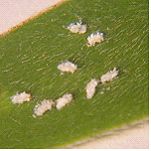
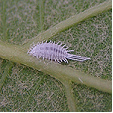
There are many types of mealybugs including;
· Longtailed Mealybugs (Pseudococcus longispinus) generally have tail filaments that are longer than there body. If squashed yellow body fluid is revealed and the eggs are laid under the body and normally hatch immediately.
· Citrus Mealybug (Planococcus citri). This insect has tail filaments that are less than 1/3 the length of its body. It produces yellow orange body fluid and lays eggs in a cottony mass.
· Citrophilous Mealybug ( Pseudococcus calceolariae). This insect has tail filaments that are about 1/3 the length of its body. It produces dark red body fluid and the eggs are laid in a cottony sac.
· Root Mealybug (Rhizeocus falcifer). This insect is not normally seen but produces a open white mass as it feeds on the outer or terminal roots, normally container plants, particularly cacti species. The eggs are laid in the waxy mass and adults may dispersed by ants.
· Hibiscus Mealybug (Maconellicoccus hirsutus)
· Tuber Mealybug (Pseudococcus affinis)
The Mealybugs (Pseudococcus adonidum) and (Planococcus citri) are a major pest of cacti species, sucking sap and turning the infected area yellow. These pests are also found on Strelitzia, Camellia and Yucca species.
Appearance and Distribution of the Pest
Mealy bugs are found worldwide. The above ground species are found in sheltered areas such as under a leaf or in leaf bases. They are also found where two fruits or leaves touch and are not readily noticeable.
The below ground species are only found when a plant is re-potted or the infected plant wilts and dies. Mealybugs are distributed several ways including slowly walking to a new host or transferred on clothing, contaminated plants or strong wind and on visiting insects. They are also farmed by ants which in a nursery situation infest pots by tunnelling and carrying mealybugs to the roots.
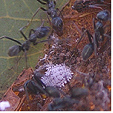 Attending Ants
Attending Ants
Life Cycle
These insects have a Hemimetabolous life cycle, ie. When the immature nymphs resemble the adults.
Up to 200 young are produced in 2-3 weeks; eggs may hatch as they are being laid. The life cycle includes eggs, nymphs (3 to 4 stages) to adult takes 6 weeks, in warmer months; several generations appear throughout the year.
Period of Activity
Active all year, particularly in spring and autumn. Warm, humid conditions are preferred and the insect overwinter outdoors as eggs. These may be found on surrounding weeds. In Citrus species many longtailed mealybugs overwinter as juveniles, maturing during spring. In a Glasshouse conditions mealybugs are active through the year.
Damage Caused
Adults and nymphs suck sap, congregating in sheltered parts of the plants; some species feed undetected on roots. Early infestations may go unnoticed until the plant begins to wilt. The insect also produces honeydew, which gives rise to sooty mould.
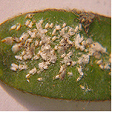
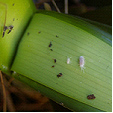 Clivia miniata
Clivia miniata
Susceptible Plants
Mealybugs are found on a wide variety of trees and shrubs. They are also destructive to many ornamentals; including indoor plants (especially African violets and ferns), and are a major greenhouse pest.
Cactus species
Many species of mealybug are common pest of cactus and succulents. The small, grey to light brown mealy bugs are difficult to see amongst the spines. Nesting females appear as the small balls of white fluff on cactus spines or around the base and under the rim of the pots. The female will produce eggs or living nymphs and the insect will produce honeydew that attracts ants. Ants should be discouraged as they farm mealy bugs, moving them from one place to another in a cactus collection.
Cactus is also attacked by the root mealybugs that infest the roots of plants and their damage allows fungal and bacterial infections to enter the plant tissue. They can be identified by white fluffy deposits in the soil or underneath a pot and appeared as tiny pinkish brown wood lice up to 3 mm long.
Catalpa species are susceptible to the mealybug (Pseudococcus comstocki) which is a wax covered mealybug that causes distorted growth of the branches and branchlets.
Fern species are commonly attacked by mealy bugs and can be recognised by small white, waxy secretions as it feeds in the crevices at vein junctions or on the exposed rhizome.
Hedera and Crassula species are susceptible to three species of mealybugs including Citrus Mealybug (Planococcus citri) and not normally requiring control.
Laburnum anagyroides is infested with the Grape Mealybug (Pseudococcus maritimus) infesting the branches and twigs.
Plumeria acutifolia becomes infested with mealybugs on the new growth but normally control is not required.
Psidium species are attacked by the Longtailed Mealybugs (Pseudococcus longispinus).
Sequoia species are attacked by three species of Mealybugs including (Planococcus citri).
Thymus species are attacked by the Root Mealybug (Rhizeocus falcifer).
Thuja species Cupressus macrocarpa and Araucaria heterophylla are can be infested with the mealybugs (Pseudococcus ryani).
Turf Grass may be infested with mealybugs causing severs damage and often go undetected and build up large colonies quickly. The turf forms brown dry patches and looks simular to Dollar Spot the infestation may also occur around core holes and can be discouraged by generous watering. Agrostis palustris (Bent) and Cynodon species (Couch) are commonly attacked.
Yucca species are attacked by the mealybug (Planococcus citri).
Cultural Control
Small plants may be sprayed with a soapy water solution or sponged down preferably during the evening. Heavily infected areas should be pruned and destroyed or the whole plant removed. Infested pot-plants should be discarded and thoroughly disinfect pots before recycling). Maintain vigour by watering to replace sap loss, this helps infected plants to recover.
As a preventative measure for root mealybugs grind up mothballs and add them to the potting mix to discourage infestations. Care should be taken as the chemicals in mothballs can damage plastic pots (use clay pots) and in some countries such as the UK. mothballs must be used as directed on the label.
Biological Control
Lacewing and ladybeetle larvae (Cryptolaemus montrouzeri) control small infestations. This predator insect requires temperatures of at least 21° C. (70°F) and in small infestations it is difficult to maintain a balance between predator and prey.
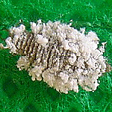
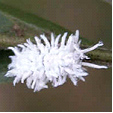
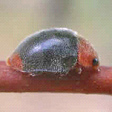
Ladybird beetle larvae eats Mealybugs Ladybird beetle up to 4 mm long
Chemical Control
Spray with white oil may have an effect on the population or spray Omethoate. Contact insecticides are usually ineffective because of the insect's protective waxy coating.
Note
Always read the label for registration details and direction of use prior to application of any chemicals.
PEST
NAME
Aphids
Various Aphid Species
ORDER
Hemiptera
FAMILY
Aphididae
Description of the Pest
The common name varies and aphids may be referred to as black fly, greenfly, ant cows or plant lice.
These small insects have soft globular body that is from 1mm to 8mm long and vary in colour from green, yellow, black and pink, with the winged forms being elongated. Both adult and nymphs, have piercing and sucking mouthparts.
Aphids are found on buds, flowers, or leaves and stems, preferring soft new growth. On older leaves the aphids are found in protected positions, such as under the leaf. Certain species of aphids form galls as they suck sap and may be found on the roots of the plant. (E.g. Woolly aphids and Black peach aphids)
Most aphids possess a pair of characteristic tubular projections, known as cornicles; these secrete a pheromone and a waxy fluid, which is thought to protect them from some of their predacious enemies.
White exoskeletons, honey dew and sooty mould indicate the presence of Aphids
Balsam Twig Aphid (Mindarus abietinus) is greenish and covered in a white wax and is normally found on the young shoots of conifers bending and killing the needles. It is found on Abies and Picea species.
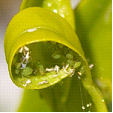 Aphid and their exoskeletons
Aphid and their exoskeletons 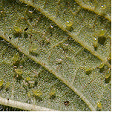 on underside of a leaf
on underside of a leaf
Black Citrus Aphid (Toxoptera aurantii) has a soft plump green body and the black coloured adults may or may not be winged. They feed in groups, curling leaves and producing honeydew attracting sooty mould.
Green Peach Aphid (Myzus persicae) is a soft plump green insect up to 0.2mm long and may be wingless. The nymphs are yellowish green and are responsible for spreading viruses in Dianthus species.
Spruce Gall Aphid (Chermes abietis) form cone shaped galls up to 12mm long resulting from the feeding. The wingless female adult lays eggs on the stems and the immature females overwinter on bud scales. Large infestation will weaken trees such as Picea abies and Pseudotsuga menziesii.
Tulip Bulb Aphid (Anuraphis tulipae) is small, waxy grey coloured and infests the underside of the bulb scales or rhizomes. They occur in the ground or on above ground parts and during storage.
Life Cycle
These insects have a Hemimetabolous life cycle, i.e. The nymphs resemble the adults.
During spring all eggs produced hatch as female nymphs. Adult Aphids are capable reproducing without fertilisation. The males are only produced in some species as the weather cools down, and the day length shortens.
Aphids are capable of giving birth to living young and large populations build up quickly during summer. Over crowding causes the aphids to become smaller, less fertile and produce more winged forms that can migrate to other host plants.
There are many different types of aphids and the life cycle varies from warm to cold climates.
Typical life cycles

Distribution of the Pest
World wide
Period of Activity
In warm climates they are seen throughout the year, but aphids dislike hot dry or cold conditions and heavy rain will decrease the population. In cold areas aphid eggs are laid around a bud base or other protected areas of the plant during autumn and emerge as nymphs during spring, feeding on the new growth.
Numbers build up quickly in the warmer months of the year. Some species feed during winter on Sow thistles.
Susceptible Plants
There is a wide range of plants attacked, from roses to vegetables, shrubs and trees. Certain aphids attack a specific genus while others have a wide range of host plants. Many are capable of transmitting plant virus diseases.
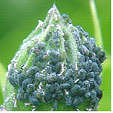 Adults and nymphs feeding
Adults and nymphs feeding 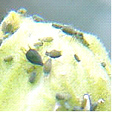 A colony of aphids
A colony of aphids
Acer species are attacked by several aphids including the Norway Maple Aphid (Periphyllus lyropictus) which is a greenish with brown markings and secret honeydew, preferring Acer platanoides. Other aphids include (Drepanaphis acerifolia) and (Periphyllus aceris) which are commonly found on the underside of leaves.
Acer species are also attacked by the Woolly Maple Aphid (Phenacoccus acericola) which covers the undersides of the leaves with a cotton-like mass
Alnus species are infested with the Alder Blight Aphid (Prociphilus tessellates) which is blue-black adult that forms woolly masses on the down-turned leaves. The nymphs overwinter in bark crevices.
Aquilegia species are attacked by several aphids including (Pergandeidia trirhoda) which is a small, flat cream coloured insect that is found on young branches and the underside of leaves.
Betula species may be attacked by the European Birch Aphid (Euceraphis betulae) which is small and yellowish or the Common Birch Aphid (Calaphis betulaecolens) which is large and green producing ample honeydew for sooty mold to grow on.
Callistephus species may be attacked by the Corn Root Aphid (Anuraphis maidi-radicis) causing the plant to become stunted, the leaves wilt and turn yellow. The aphids feed on the roots producing honeydew and are dispersed to other host by ants. It is also attacked by the Potato Aphid (Macrosiphum solanifolii).
Carya species are attacked by Gall Aphids (Phylloxera caryaecaulis) which is found on the leaves, twigs and stems forming galls and turning them black.
Chaenomeles and Gladiolus species, new growth and leaves become infested with the aphid (Aphis Gossypii)
Cupressus macrocarpa may become infested with the Cypress Aphid (Siphonartrophia cupressi).
Cyclamen species are attacked by the aphid (Myzus circumflexus) and (Aphis gossypii) which can infest healthy plants.
Dendranthema, Dianthus and Crocus species are attacked by several types of aphid including the Green Peach Aphid (Myzus persicae) and the Chrysanthemum Aphid (Macrosiphoniella sanborni).
Hibiscus species are attacked by the aphids (Aphis craccivora) and (Aphis gossypii), both congregate towards the branch tips and may cause leaf curl. Normally only seen in sub-tropical climates.
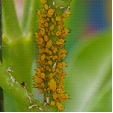 Aphids on a stem
Aphids on a stem 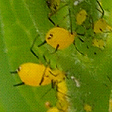 Mandevilla species
Mandevilla species
Larix species is attacked by the Woolly Larch Aphid (Adelges strobilobius). The winged adults deposit eggs at the base of the needles during spring and white woolly areas appear attached to the needles where the adult aphids feed. The young aphids overwinter in the crevices of the bark.
Mandevilla species is attacked by aphids that congregate towards the branch tips and may cause leaf curl.
Pinus species is attacked by several species of aphid including Pine Bark Aphid (Pineus strobi), Pine leaf Aphid (Pineus pinifoliae) and the White Pine Aphid (Cinara strobi).
Primula species are attacked by four species of aphid including foxglove, and green peach aphid.
Rudbeckia, Delphinium, Chrysanthemum and Helianthus species are attacked by a bright red aphid (Macrosiphum rudbeckiae).
Sorbus aucuparia is affected by the Rosy Apple and Woolly Apple aphid which attacked the foliage and young shoots.
Spiraea species are attacked by the Aphid (Aphis spiraecola) which feeds on the young shoots and flowers.
Tropaeolum species are attacked by the Black Bean Aphid (Aphis fabae), which is found in large numbers on the underside of the leaves, turning them yellow and causing them to wilt then die.
Tulipa, Iris, Freesia, Gladiolus and Zephyranthes species are infested with the Tulip Bulb Aphid.
Ulmus species are infected by two types the Woolly Apple Aphid (Eriosoma lanigerum), which curls and kills young terminal leaves and the Elm Leaf-Curl Aphid (Eriosoma ulmi) which occasionally attacks the trees.
Viburnum species are attacked by the Snowball Aphid (Anuraphis viburnicola). This aphid congregates at the end of the branches causing the leaves to curl and become deformed under which they hide.
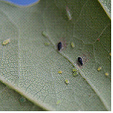 Aphids on Quercus robur
Aphids on Quercus robur
Damage Caused
Buds that have been attacked may not open, leaves and twigs become twisted or distorted and wilt. The aphids also produce honeydew, which is sticky and attracts sooty mould (fungus). This fungus forms a thick layer over the leaf, fruit or stems reducing the plants photosynthesis capability. The sooty mould spoils the plants appearance and its fruit, as does the insects white exoskeletons.
Control
Cultural Control
Aphids may be removed from a plant by hosing them off with water (limited success) or applying soapy water to aphids.. Another organic sprays can be efficient in controlling aphids. Aphids may also be removed physically by hand for small colonies on spine less plants. Species that live under ground are difficult to control but cultivation of the surrounding soil may help in controlling the infestation. (limited mainly to annual or commercial crops)
Reflective mulch around the plants also reduces numbers by repelling the insect this material is available commercially. (Reflective mulches are mainly used in market gardens for avoiding the Green peach Aphids) Resistant rootstocks are available to avoid some root feeding aphid of commercial plants, e.g. Vines and fruit trees
Biological control
Aphids are attacked by several insects includes parasitic wasps or predators such as ladybirds/ lady beetles, hover flies, lacewings, spiders.
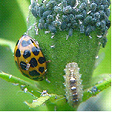
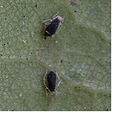 Parasitised aphids
Parasitised aphids
Chemical Control
Aphids may be controlled by spraying with a contact or systemic insecticide. The type of application used will depend on the plant is being attacked.
Aphids can be suffocated and therefore controlled with the use of e.g. White oil, Pest oil, Soapy water from soap such as Lux Flakes ®
Note
It is your responsibility by law to read & follow the directions on the label of any pesticide
Monitoring
Aphid are attracted by yellow colour and traps such as boards painted yellow and covered in glue or sticky substance will attract and trap the insects. There is also a commercially sticky yellow tape that can be attached to susceptible plants
Amendments by B. Sonsie Dip Hort Sc Burnley
Note: Plants affected by this pest are Deer Resistant plants not the susceptible plants.
PEST
NAME
Deer
Cervus species
ORDER
Artiodactyla
FAMILY
Cervidae

Description of the Pest
There are two species of the deer in North America, the Whitetail (Odocoileus virginianus) and the Mule deer (Odocoileus hemionus) with several regional variations such as the Pacific coastal Blacktail (O.h. columbianus) which is regarded as a sub-species of the Mule deer.
The Whitetail on average grows to 112 cm (44in) tall and 180 mm (70 in) long and weigh 68 kgs (150lbs). The fir colour varies according to its environment but generally it is reddish-brown during summer and grey-brown in winter with a pure white underside on its tail. When the tail is erect it is known as the "white flag". Its antlers consist of two main beams from which the points emerge.
The Mule deer grow to 105 cm (42 in) tall and are up to 200 cm (80 in) long with the adult buck weighing up to 137 kgs (300 lbs) and the does up to 80 kgs (175 lbs). The fir is generally tawny brown during summer and during winter it has a heaver grey-brown to blue-grey coat with a small white tail that is tipped in black. The other distinguishing features are its ears that are up to 300 mm (1 ft) long (mule-like) and its antlers, with the two beams that are forked into smaller beams, which inturn fork again and again.
The Blacktail deer (Pacific coastal Blacktail) grows to 97 cm (38 in) tall and is up to 105 cm (60 in) long and weighs on average 73 kgs (160 lbs). The fir is generally tawny brown during summer and during winter it has a heaver grey-brown to blue-grey coat with a tail that is dark brown at the base then changing to black for 50% of its length. The antlers consist of two beams that are forked into smaller beams, which inturn fork again and again.
Appearance and Distribution of the Pest
The Whitetail deer are found throughout eastern United States, on the coast and inland but are not commonly seen in California, Utah or Nevada. They do not migrate but congregate together (yard up) during winter and feed in a part of their existing territory.
The Mule Deer are found in the western part of North America from South eastern Alaska to Mexico and from the Pacific coast to Texas. They migrate from highland mountain meadows to southern or lower snow free forested valleys during winter.
The Blacktail deer are found on the Pacific coast from Alaska to northern California. There is both resident and migratory Blacktails. The migratory Blacktails move southwards during late autumn at the first sigh of snow or heavy sustained rain and the resident Blacktails seek cover their existing territory amongst woodlands during the winter months.
Life Cycle
All Deer breed from autumn to early winter and the does give birth from late spring to early summer.
Period of Activity
Deer are most active from spring to autumn but can be troublesome during winter when the feed is scarce. In some regions urban landscapes become the major food source both in summer and winter.
Damage Caused
Browsing deer will feed on almost any plant and is most commonly noticeable during spring feeding on the new growth or twigs and stems leaving a shredded appearance. Deer also rub their antlers against trees damaging bark and snapping off small branches, this action also incurs damage under hoof as plants, lawns and garden structures are trampled on.
Susceptible Plants
Some plants are more palatable to deer but when a deer is hungry or during drought conditions there are no "Deer Proof" plants. There is a range of plants that have a bad taste and are not destroyed and are regarded as (deer resistant plants). Deer resistant plants are the plants that are attached to this file not the susceptible plants.
Cultural Control
There are many cultural controls that have been tried to move browsing deer such as frightening them with strobe lights, pyrotechnics or tethered savage dogs. These actions are only temporary and may cause more trouble as the stampeding animals move off. Fencing and netting can be an effective method of discouraging hungry deer from gardens but may be expensive on a large scale and require maintenance. There are several types of fences which include conventional 2.2m (8 ft) deer-proof woven wire fences or single-wire electric fences and slanted deer fences. Plant selection can also be effective, by using less desirable plants (deer resistant plants) as an outer border to the more desirable plant species and thus discouraging the deer to enter the garden. Hedges and windrows of less desirable thorny plants can also be a deterrent to browsing deer.
Chemical Control
There are two main types of repellents contact and area. Contact repellents are applied directly to the plants and deter deer with a bad taste or smell. They can be applied by rubbing or spraying on to the plants and commonly used in an egg mixture. The commercial products have proven to work better than home remedies which include soap or chilli mixtures and hanging bags of human hair.
Area repellents rely on an offensive odour and are placed around areas that are frequently visited.
Contact your local distributor for available types and application.
DISEASE
NAME
Fusarium Wilt (General)
Various Wilt Species
Description
Fusarium wilt is caused by specialised strains of the common soil fungus, Fusarium oxysporum.This fungus is microscopic, and that can live in the soil for many years and primarily attacks plants by entering through the roots. This affects corms, stems and leaves by moving through the water conductive tissue in the plant.
The specialised strains are known as formae speciales (f. sp. or special forms) and each f. sp. has a relatively narrow host range. For example Fusarium oxysporum f. sp. cubense causes Panama wilt of banana, F. oxysporum f.sp. vasinfectum infects cotton and F. oxysporum f. sp. lycopersici attacks tomatoes. Each strain is specific to that narrow host range and will not affect other hosts; this is important as it makes control options involving the planting of other plant species possible.
Symptoms
Generally the plant wilts quickly during hot weather or lacks growth and vigour. Typically the symptoms are often indistinguishable from drought stress. Leaves yellow and wither or stems split open near the base. Individual branches may collapse and die or entire plants perish. One of the distinctive symptoms is a one-sided yellowing and death of a leaf or branch. Corms become rotted with open wounds and affected stems, when split open are yellowish. There are variations in the symptoms depending on the type of plant but generally plants wilt, turn brown and die.

Basal Rot (Fusarium oxysporum) infects Tulipa and Crocus species by turning leaves reddish, which wilt and normally die. It also affects the bulbs by forming few roots and rotting the base, turning them dull white.
This disease also infects cactus such as Cereus species and Zygocactus truncatus causing soft black rot that appears at the tips of the plant then spread rapidly downwards. It is particularly virulent in hot beds, under glass. The infected plants cannot be cured and should be disposed off site.
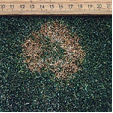 Fusarium Patch, Bent
Fusarium Patch, Bent 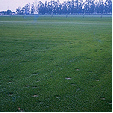 Fusarium Patch, Blue Grass
Fusarium Patch, Blue Grass
Other Fusarium (or related species) diseases
Fusarium Patch (Microdochium nivale formerly known as Fusarium nivale) is also known as Crown or Root Rot and infects warm or cool season Turf Grasses. The fungus infects the roots or rhizome turning them black, sometimes with a pink ting. During hot periods light green to brown patches appear in the turf as the damaged roots are unable to supply water to the leaves. This diseases is not a significant disease in Australia
Minimise irrigation of infected areas to reduce spread of infection as the spores are distributed in water.
Root Rot (Fusarium verticillioides) is a seed born fungus that infects Strelitzia reginae. It also forms a Leaf Spot in Dracaena species where rounded or irregular yellowish to reddish spots with a pail green border form. These are found on immature leaves and heavy infections may rot the crown.
Source and Dispersal
The fungal spores are dispersed by wind from infected plants or parts of plants. It is also dispersed by splashing water or contaminated stock or the movement of soil. With Fusarium wilt of canary island date palms the transfer of infected plant material on chain saws has been shown to be an important way in which the fungus can be transmitted from one tree to another. It is essential in these cases to sterilise the chain and chain bar between trimming the fronds on each tree.
Fusarium oxysporum produces three types of species, macroconidia, microconidia and chlamydospores. The latter two spore types play very important roles in the disease. The microconidia move in the vascular system of the plant and collect at the sieve plates in the xylem of plant. Here they germinate and grow and eventually block the sieve plate thus stopping the flow of water in the plant. The chlamydospores are specialised survival spores that persist in roots and in the soil for very long periods of time, thus allowing the fungus to survive periods when there are no susceptible plants present.
Favoured Conditions
The fungus prefers warm humid climates and is commonly seen in coastal regions and may continue living in soil for many years.
Affected Plants
Many species are infected including tomatoes, carnation, cucurbits and freesia. Die Back (Fusarium solani var. martii) causes damage to the branches of Ilex species. Fusarium also attacks palm species such as Phoenix causing wilt.
Albizia and Alternantera species are infected by the wilt (Fusarium oxysporum var. periciosum ) that causes the leaves to wilt, shrivel and die. This infection also extends to the branches and eventually may kill the tree.
Callistephus species are attacked by the wilt (Fusarium oxysporum f. sp. callistephi) which infects the vascular bundles turning brown, particularly on one side of the stem causing the plant to become stunted, eventually dieing.
Dendranthema and Thymus species are susceptible to the Stem Rot (Fusarium species) and (Pellicularia filamentosa) which rots the base of the stem.
Dianthus species are infected by Bud Drop (Fusarium poae). This fungus rots flower buds prior to opening and infected flowers open with distorted, unattractive petals. The control of thrips is essential. Dianthus species are also infected by Wilt (Fusarium oxysporum) that causes yellowing and wilting of the lower leaves, normally on one side. The infection causes stems to rot with vascular discolouration.
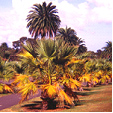
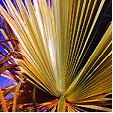 Fusarium Wilt Image by B. Sonsie
Fusarium Wilt Image by B. Sonsie
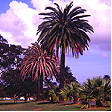
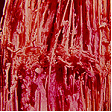 Image by Dr Brett Summerell
Image by Dr Brett Summerell
The only palms susceptible to Fusarium wilt are Phoenix species, especially Phoenix canariensis and juvenile Washingtonia filifera. Initially the leaflets turn yellowish then brown, on mature fronds causing them to die. Eventually only tufts of new growth remain the plant. As the infection continues the plant collapses and dies.
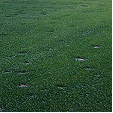 Fusarium Patch
Fusarium Patch
Turf grasses are infected by Fusarium Patch (Microdochium nivale). Plants include; Digitaria didactyla (Blue Couch), Cynodon species (Couch), Eremochioa ophiuroides (Centipede Grass), Festuca species, Paspalum vaginatum (Salt Water Couch), Pennisetum clandestinum (Kikuyu), Poa species (Bluegrass), Stenotaphrum secundatum (Buffalo) and Zoysia species. Generally the fungus produces small dead circular patches in the lawn.
Non-chemical Control
Fusarium diseases are extremely difficult diseases to control primarily because of a lack of a chemical control option and because the fungus is able to persist in soil for long periods of time. Crop rotation to non susceptible plants is advised and consequently it will be important to have the disease accurately diagnosed to ensure the identity of the pathogen and the possible rotation options.
Remove and destroy any infected plants. In the case of large trees or palms, it will be necessary to remove the infected plant, this not only means cutting down the above ground parts, but also removing the roots of the plant. These will then need to be removed and destroyed.
Fusarium Patch can be minimised by reducing thatch and aerating the soil regularly or improving the drainage.
Chemical Control
There are no effective chemical control options currently available for plant diseases caused by Fusarium species.
Note
Always read the label for registration details and direction of use prior to application of any chemicals.
Amendments by
Dr Brett Summerell
Director Science and Public Programs
Royal Botanic Gardens Trust, Sydney
DISEASE
NAME
Root Knot & Other Nematodes
Meloidogyne & other species
Description
Root Knot Nematode or eelworms are transparent thin nematodes that are an organism up to 0.5mm long and attacks the roots by injecting saliva that stimulates the surrounding cells to form galls. The adult male lives in the soil and the female are found in the roots, laying up to 2,000 eggs in a mass in the soil adjoining the roots.
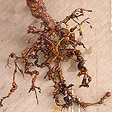
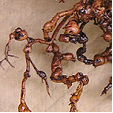
Symptoms
Above ground the plant infected by Root Knot Nematode develops slowly and is stunted. During hot weather the plant wilts easily as it is unable to keep up with the transpiration rate and under extreme conditions the plant dies. The young nematodes attack the roots forcing there way up the root tips forming galls. On inspection the galls are found centrally located along the roots and are up to 20mm across. The galls slow the rate of nutrients and water passing through the plant and as the galls break down they allow opportunity for other diseases to enter the plant.
The roots are severely damaged if the galls are physically removed.
Other species of nematode have simular symptoms and are individually discussed below.
Source and Dispersal
The nematodes are found in soil or in infested plants and are dispersed by water, soil movement and attached to tools or shoes.
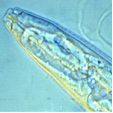 Nema Head
Nema Head
Favoured Conditions
It prefers sandy soil types and a warm moist weather conditions.
Life Cycle
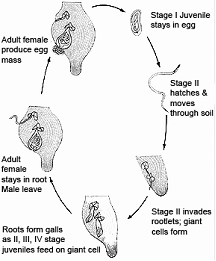
Affected Plants
A wide range of plants are attacked by the Root Knot Nematode including tomatoes, potatoes, carrots, tobacco, hibiscus, gardenia and roses. Some species of nematodes are plant specific such as (Meliodogyne incognita) which attacks Hemerocallis, Celosia and Viola species, forming small wart-like swelling on the roots.
Alternanthera, Begonia, Dianthus, Psidium, Thunbergia and Weigela species are attacked by the Root Nematode (Meloidogyne incognita). This forms small swellings on the roots causing the top growth to be stunted and not responding to improved culture. In cool climates it is found on plants in glasshouses.
Buxus species are attacked by the Meadow Nematode (Pratylenchus species) that turn the leaves a bronze colour and cause stunting of the plant. These microscopic nematodes enters through the roots and eventually result in the death of the plant.
Lagunaria patersonii is attacked by a simular nematode, the Root Burrowing Nematode (Radopholus similis) that feeds by burrowing in the outer root tissue.
Lavandula species that are grown in the northern United States are susceptible to the Peanut Root Knot Nematode (Melioidogyne hapla). Berberis species are also susceptible.
Tulipa species are attacked by Bulb and Stem Nematode (Ditylenchus dipsaci) which forms brownish streaks along the stem that may blister and may cause wilting. The flowers petals become distorted and the general vigour of the plant poor.
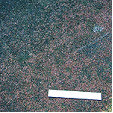
 Nematodes damage
Nematodes damage
Turf Grass are susceptible to several Parasitic Nematodes including (Helicotylenchus species), (Xiphenema Species), (Hemicycliophora species) and (Ibipora lolii). All turf grasses are susceptible and the nematodes are active from spring to autumn requiring a soil temperature 15 ºc. The leaves become chlorotic and have a weak appearance as a result of the damaged roots. Generally it is only a major problem when the nematode numbers are very high, otherwise control is not warranted.
Cultural Control
Crop rotation in infected soils, avoid using plants from the Brassicaceae family for up to four years and plant species that are tolerant of nematodes, this will reduce numbers. Beds may be laid fallow for several seasons to deter nematodes, but numbers build up quickly once susceptible plants return.
Affected plants such as roses may have the bare roots dipped in hot water 45ºC for 15 minutes during the dormant period and contaminated growing media can be heat treated at 60ºC for 30 minutes before being used.
Any infested plants should be removed and destroyed or deposed off site.
Improve the soil structure and avoid acidity by the addition of lime or dolomite. Garden beds may also be pre planted with marigolds or mustard to deter nematodes, but should be removed or thoroughly composted prior to planting as they can push nematodes towards the crop. Green manure crops may be grown prior to planting and infested soil may require up to three seasons of manure crops to bring nematodes under control.
Biological Control
The encouragement of earthworms reduces nematode numbers as they accidentally eat them in there normal course of growth.
Chemical Control
The soil can be treated with a nematicide such as fenamiphos in a domestic situation. Commercial growers may fumigate the soil prior to planting with the appropriate chemicals.
Note
Always read the label for registration details and direction of use prior to application of any chemicals.
Average Lowest Temperature : -1º C 30º F
USDA : 9, 10, 11
This USDA (United States Department of Agriculture) hardiness zone chart can be used to indicate a plant’s ability to withstand average minimum temperatures. However, other factors such as soil type, pH, and moisture, drainage, humidity and exposure to sun and wind will also have a direct effect on your plant’s survival. Use this chart only as a guide, always keep the other factors in mind when deciding where, when and what to plant.
A plant's individual USDA zone can be found in the Plant Overview.
Region of origin
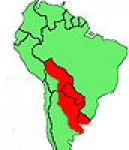
South America, (Bolivia, Uruguay, Paraguay, Argentina)
Climate Description
Warm to Sub-tropical
This overlaping zone has ample rain with high summer temeperatures and high humidity. Winters are mild. Pockets of sub-tropical climates exist within coastal warm temperate zones.
Frosts and droughts rarely occur along the coast.
Plant growth
Tropical and warm temperate native and exotic plants grow well.
| Dictionary | Growth Habit |
| Leaf Type | Botanic Flower Description |
| Leaf Shape | Flower Inflorescence |
| Leaf Arrangement | Fruit Type |
| Leaf Margin | Bark Type |
| Leaf Apex And Bases | Flower Description |